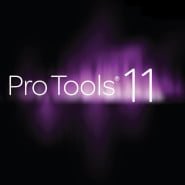ProTools 11 Review
Posted by Dan Israel on Feb 21, 2014 in Audio
I’ve resisted going to ProTools 11 due to the requirement for AAX plugs. I was holding out for Waves to do DSP versions, not just Native. Another program forced me to Maverick (OS X 10.9) which put an end to my coexistence of 10.3.8 and 11.0.1. What I didn’t realize over the past year, is I rarely booted into 11. So, I’m just now spending my first three weeks of significant time in version 11 – and I can’t believe I haven’t been using it all along.
The verdict for me is a resounding YES!
IMHO, Avid hadn’t done a lot with ProTools since the Digidesign days. As it turns out, that time was likely being invested in the preparation and plug-in architecture rewrite that has culminated in version 11. And for the first time in a long time, I’m excited about the possibilities. Here is a run-down of the changes that most impress me in the order of importance:
NON REAL-TIME BOUNCE
Avid calls this “OFFLINE” and it has to be the single best feature, not to mention the most requested since ProTools 1 (or should I say SoundTools). I was always a fan, and still am, of real-time bouncing. So many times, I have received prints and stems from other facilities with pops or glitches in the audio. So, for critical work I want to hear every sample before publishing or sending off to the next stage. In the days of TDM, I rarely had a glitch due to processing issues. And I never had a file contain something I didn’t hear while it was bouncing. To some degree, real-time bouncing may make even more sense as we shift more audio processing to the computer’s CPU (Native). But there is no doubt for non-critical bounces, Offline Mode is straight from heaven.The speed varies depending on session complexity. I’ve done some broadcast bounces at almost 100x real-time, including a 3 hour show that bounced in only 4 minutes. But an extremely complicated session (many tracks and plug-ins), may only be 2-3 times faster than real-time. Still significant!
METERING
Metering has been playing catch-up in our industry almost since the Digital F-1 format was released in the Mid-80s. Nowhere has that been more apparent than in DAWs. Over the past couple of years several third parties have dramatically improved this. In particular, I’ve been using
Insight from iZotope’s Ozone Advanced, which has a slew of powerful meters and analyzers. Until then I heavily relied on console and outboard meters.In PT11, the metering is dramatically improved. The ballistics are far more relateable and responsive. And you can set audio channels to one setting while output channels can be another. Since I do a wide variety of work, I’m a fan of Bob Katz’s
K-system. Version 11 allows me to set a pop music session’s audio tracks at K14, and it’s output channels at K-12. Or for a more dynamic project, the audio channels at K20 and the output at K14. Or for broadcast session, everything can be set to K-12. And there are almost a dozen possibilities for meter settings.
TRACK COUNT/POWER
Avid completely rewrote the audio engine. Finally the days of throttling down the number of CPUs is over. The new engine is far more intelligent and efficient. You can literally watch it adjust with System Usage. The playback cache’ing finally works as you would imagine too. I never understood how the old settings seemed to be useless. For the record, I’m using a MacPro 5,1 (2013) 12 Core with HDX. The track count and plug-in power is very impressive. I opened a full orchestral session that had over 100 tracks. Previously I had to bounce sub-mixes and deactivate tracks to allow the hard drive and CPUs to keep up.
BOUNCE NAMEThis one is a bit silly, but PT11 stores the name of the bounce in the bounce dialog now rather than relying on the “Save As” dialog box. For my workflow, outputting is now almost effortless – not to mention consistent.
MULTIPLE BOUNCE PATHS
Version 11 allows multiple bounces to occur at the same time. The possibilities for this are endless, such as a 5.1, Stereo, and mono bounces all to occur at the same time. Or a bounce with dialog and f/x , and down-mix. But the most common is the ability to make both a .wav & .mp3 at the same time. I know!!You can also have it automatically “Add to iTunes” or publish on social media. Not sure this is super valuable, but to some workflows could be a welcome convenience.
SUMMARY
I’m sure there is more in this release then I’ve mentioned. But if you’ve been waiting, don’t! PT11 hasn’t lost any of the good from previous versions other than older plugs format – which granted, can be frustrating to lose if there isn’t an AAX version. I lost TL Aggro plugs. But I would rather re-learn a replacement plug or two to gain the feature of version 11.
